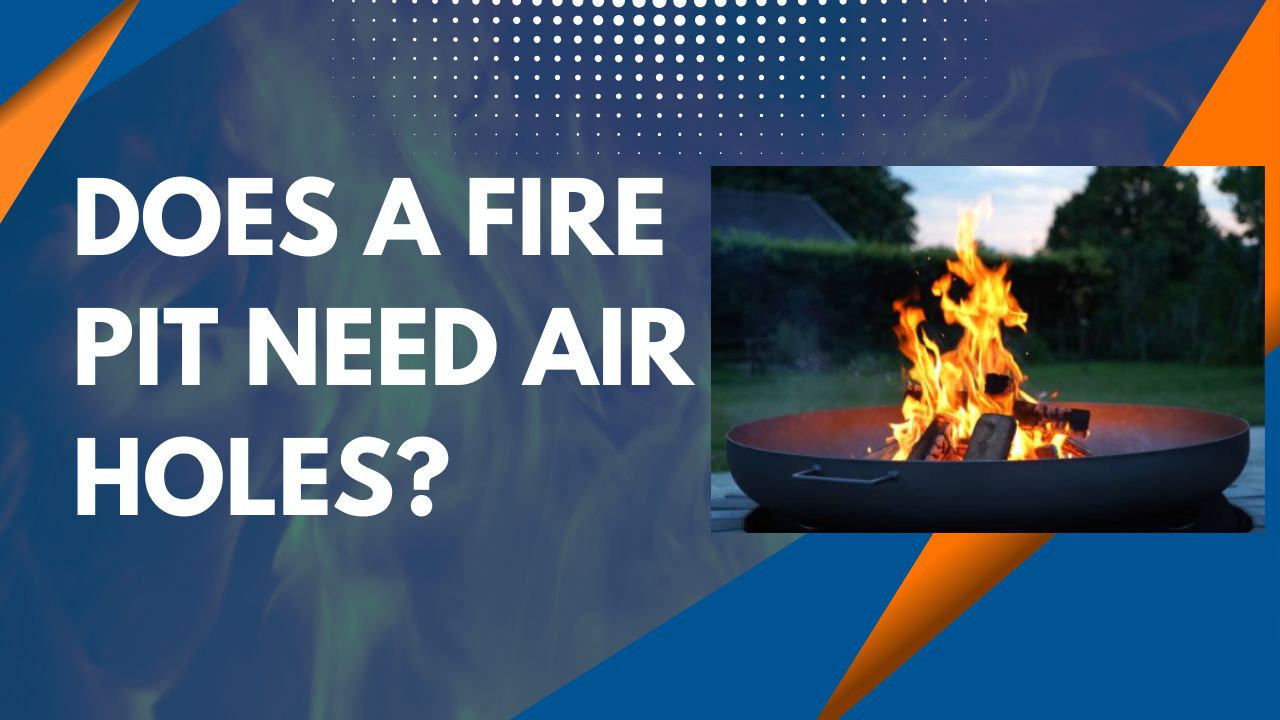
Does a Fire Pit Need Air Holes? Understanding the Importance of Airflow for Optimal Burn
Are you frustrated with smoky, struggling fires that won't stay lit? Yes, fire pits need proper airflow through air holes or ventilation features – without adequate oxygen supply, you'll battle excessive smoke, poor combustion, and disappointing heat output. Understanding airflow principles transforms frustrating fire experiences into efficient, enjoyable outdoor entertainment.
Fire Pit Design: More Than Just a Container
Fire Pit Common Perceptions
Many people view fire pits as simple containers for burning wood, overlooking the sophisticated engineering required for optimal performance, safety, and user satisfaction.
Quality fire pit design involves careful consideration of materials, Ventilation, heat distribution, and combustion efficiency that separate premium products from basic alternatives.
Fire Pit Air Circulation: The Overlooked Factor
Air circulation plays a critical role in fire dynamics that most users never consider until they experience poor performance from inadequately designed units.
Fire Pit Airflow Impact affects everything from ignition ease and heat output to smoke production and fuel consumption, making ventilation design crucial for user satisfaction.

Fire Pit Combustion Science: Why Air Matters Critically
Fire Pit Fire Triangle: Oxygen Requirements
Fire Pit Combustion requires three elements working together: fuel, heat, and oxygen. Without adequate oxygen supply, even perfect fuel and ignition sources cannot sustain efficient burning.
Fire Pit Oxygen Supply, through proper Ventilation, enables complete combustion that maximises heat output while minimising smoke production and fuel consumption.
Fire Pit Incomplete Combustion Problems
Poor airflow in a fire pit creates incomplete combustion, where fuel burns inefficiently, producing excessive smoke, reduced heat output, and difficulty maintaining sustained fires.
Fire Pit Combustion Symptoms without adequate air include smoky burning, frequent flame extinguishing, poor ignition, and wasted fuel through inefficient burning processes.
Fire Pit Airflow: How Air Holes Improve Performance
Fire Pit Efficient Burning Benefits
Fire Pit Oxygen Supply Enhancement through strategically placed air holes provides steady airflow to fire bases and throughout burning zones, enabling optimal combustion conditions.
Fire pit temperature increases as a result of complete combustion, which achieves higher burning temperatures and creates more radiant heat for user comfort and cooking applications.
Fire Pit Fuel Efficiency improves dramatically with proper airflow, as complete combustion extracts the maximum energy from each piece of wood while reducing waste through unburned materials.

Fire Pit Smoke Reduction
Fire Pit Complete Combustion achieved through adequate airflow burns fuel completely, dramatically reducing smoke production through elimination of unburned particles and incomplete combustion byproducts.
Fire Pit Australian Compliance becomes crucial in residential areas where smoke nuisance regulations and neighbour relationships require clean-burning fires that minimise air quality impacts.
Fire Pit Council Regulations increasingly focus on smoke production, making efficient burning essential for maintaining good community relationships and avoiding enforcement actions.
Fire Pit Starting and Maintenance
Fire Pit Quick Ignition benefits from ample airflow that helps to kindle catch fire rapidly while providing a sustainable oxygen supply for flame development and maintenance.
Fire Pit Sustained Burning prevents fires from smouldering and extinguishing through consistent oxygen delivery, maintaining optimal combustion conditions throughout the burning cycle.
Fire Pit Maintenance Reduction results from efficient burning that produces less ash creates fewer unburned remnants, and requires less frequent fuel addition for sustained heat.
Fire Pit Heat Output Enhancement
Fire Pit Radiant Heat increases significantly with hotter, more efficient fires that achieve complete combustion through adequate oxygen supply and optimal burning conditions.
Fire Pit Thermal Efficiency enables maximum heat extraction from fuel while minimising waste through incomplete burning that characterises poorly ventilated fire pit designs.
Fire Pit Ventilation: Different Airflow Approaches
Fire Pit Built-in Air Holes and Vents
Fire Pit Manufactured Ventilation incorporates strategic holes or slots positioned at bases or sides to optimise oxygen delivery while maintaining structural integrity and aesthetic appeal.
Fire Pit Smokeless Designs utilise sophisticated double-wall construction with precision air holes that create secondary combustion, dramatically reducing smoke while increasing heat output efficiency.
Fire Pit Engineering in premium models balances airflow optimisation with safety, durability, and visual appeal through carefully calculated ventilation systems.

Fire Pit Raised Base Benefits
Fire Pit Elevation creates crucial air gaps underneath units, allowing oxygen to be drawn from below and providing a natural draft that enhances combustion efficiency.
Fire Pit Leg Design in quality models ensures adequate ground clearance while maintaining stability and safety during operation and adverse weather conditions.
Fire Pit Open Design Advantages
Fire Pit Ring Ventilation allows air entry from all sides, providing maximum oxygen access while maintaining simple, cost-effective construction methods.
Fire Pit Bowl Designs balance airflow optimisation with ember containment, creating effective Ventilation while maintaining safety and usability.
Fire Pit DIY Considerations
Fire Pit Masonry Ventilation requires designing gaps or channels at bases during construction to ensure adequate air intake without compromising structural integrity.
Fire Pit Metal Liner Benefits often include built-in ventilation holes, providing space for natural airflow around the liner's perimeters.
Fire Pit Custom Construction requires an understanding of airflow principles to achieve optimal performance through proper ventilation design and implementation.
Fire Pit Poor Ventilation: Consequences of Inadequate Airflow
Fire Pit Ventilation Problems
Fire Pit Excessive Smoke results from incomplete combustion where inadequate oxygen creates unburned particles that irritate users and neighbours while violating air quality standards.
Fire Pit Ignition Difficulties occur when insufficient airflow prevents kindling from catching fire quickly or sustaining flames during initial burning phases.
Fire Pit Weak Flames struggle to maintain intensity without adequate oxygen supply, creating disappointing heat output and unreliable burning performance.
Fire Pit Fuel Waste increases dramatically when incomplete combustion fails to extract maximum energy from wood while leaving significant unburned residues.
Fire Pit Australian Climate Considerations
Australian conditions, including variable humidity, seasonal winds, and bushfire awareness, make efficient burning particularly important for safety and regulatory compliance.
Fire Pit Weather Adaptation requires ventilation systems that function effectively across diverse Australian climate conditions while maintaining optimal performance.
Fire Pit Technology and Innovation
Modern fire pit designs incorporate advanced ventilation technologies, including computer-modelled airflow patterns, precision-engineered air holes, and innovative combustion chambers.
Fire Pit Performance Optimisation continues evolving through engineering advances that improve efficiency while maintaining safety and aesthetic appeal.
Fire Pit Investment Considerations
Quality fire pits with proper ventilation design provide superior long-term value through reduced fuel consumption, improved user experience, and enhanced safety compliance.
Fire Pit Purchase Decisions should prioritise ventilation features that ensure optimal performance rather than focusing solely on aesthetic appeal or initial cost considerations.
Conclusion: Fire Pit Air Holes Enable Optimal Performance
Fire pits require adequate airflow through air holes or ventilation features to achieve efficient, hotter, and less smoky burning, creating a satisfying outdoor experience.
Proper ventilation design contributes significantly to superior fire pit performance while enabling effective smoke management, which is crucial for Australian backyard use and maintaining good neighbour relationships.
Invest in well-ventilated fire pit designs that prioritise airflow optimisation rather than risking disappointing performance from inadequately ventilated alternatives that waste fuel while producing excessive smoke.

